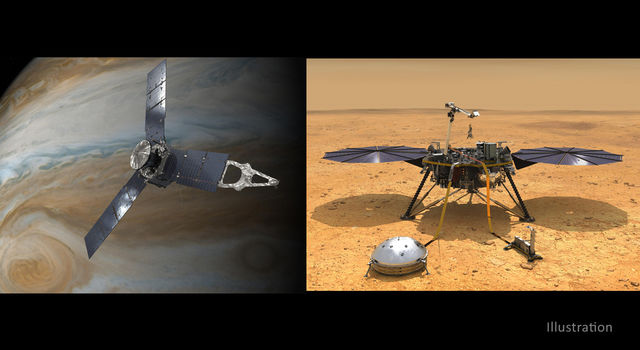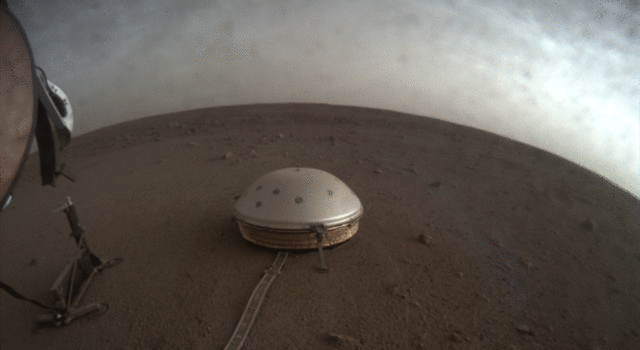Blogs | Dawn Journal | September 27, 2015
Dawn Celebrates Eight Years, Two Stellar Orbits
Dear Dawnniversaries,
Eight years ago today, Dawn was gravitationally bound to a planet. It was conceived and built there by creatures curious and bold, with an insatiable yearning to reach out and know the cosmos. Under their guidance, it left Earth behind as its Delta rocket dispatched it on an ambitious mission to explore two of the last uncharted worlds in the inner solar system. As Earth continued circling the sun once a year, now having completed eight revolutions since its celestial ambassador departed, Dawn has accomplished a remarkable interplanetary journey. The adventurer spent most of its anniversaries powering its way through the solar system, using its advanced and uniquely capable ion propulsion system to reshape its orbit around the sun. On its way to the main asteroid belt, it sailed past Mars, taking some of the that red planet's orbital energy to boost its own solar orbit. On its fourth anniversary, the probe was locked in orbit around the giant protoplanet Vesta, the second most massive object between Mars and Jupiter. Dawn's pictures and other data showed it to be a complex, fascinating world, more closely related to the terrestrial planets (including one on which it began its mission and another from which it stole some energy) than to the much smaller asteroids.

Today, on the eighth anniversary of venturing into the cosmos, Dawn is once again doing what it does best. In the permanent gravitational embrace of dwarf planet Ceres, orbiting at an altitude of 915 miles (1,470 kilometers), Dawn is using its suite of sophisticated sensors to scrutinize this mysterious, alien orb. Ceres was the first dwarf planet ever sighted (and was called a planet for more than a generation after its discovery), but it had to wait more than two centuries before Earth accepted its celestial invitation. The only spacecraft ever to orbit two extraterrestrial destinations, this interplanetary spaceship arrived at Ceres in March to take up residence.
Although this is the final anniversary during its scheduled primary mission, Dawn will remain in orbit around its new home far, far into the future. Later this year it will spiral down to its fourth and final orbital altitude at about 230 miles (375 kilometers). Once there, it will record spectra of neutrons, gamma rays, and visible and infrared light, measure the distribution of mass inside Ceres, and take pictures. Then when it exhausts its supply of hydrazine next year, as it surely will, the mission will end. We have discussed before that despite the failure of two reaction wheels, devices previously considered indispensable for the expedition, the hardy ship has excellent prospects now for fulfilling and even exceeding its many goals in exploring Ceres.
Last month we described the plans for Dawn's penultimate mapping phase at the dwarf planet, and it is going very well. The probe is already more than halfway through this third orbital phase at Ceres, which is divided into six mapping cycles. Each 11-day cycle requires a dozen flights over the illuminated hemisphere to allow the camera to map the entire surface. Each map is made by looking at a different angle. Taken together then, they provide stereo views, so scientists gain perspectives that allow them to construct topographical maps. The camera's internal computer detected an unexpected condition in the third cycle of this phase, and that caused the loss of some of the pictures. But experienced mission planners had designed all of the major mapping phases (summarized here) with more observations than are needed to meet their objectives, so the deletion of those images was not significant. At this moment, the spacecraft is nearing the end of its fourth mapping cycle, making its tenth flight over the side of Ceres lit by the sun.
You can follow Dawn's progress by using your own interplanetary spaceship to snoop into its activities in orbit around the distant world, by tapping into the radio signals beamed back and forth across the solar system between Dawn and the giant antennas of NASA's Deep Space Network, or by checking the frequent mission status reports.
You also can see the marvelous sights by visiting the Ceres image gallery. Among the most captivating is Occator crater (see the picture below). As the spacecraft has produced ever finer pictures this year, starting with its distant observations in January, the light reflecting from the interior of this crater has dazzled us. The latest pictures show 260 times as much detail. Dawn has transformed what was so recently just a bright spot into a complex and beautiful gleaming landscape. Last month we asked what these mesmerizing features would reveal when photographed from this the present altitude, and now we know.

Scientists are continuing to analyze Dawn's pictures and other data not only from Occator but all of Ceres to learn more about the nature of this exotic relict from the dawn of the solar system. Many deep questions are unanswered and remain mystifying, but of one point there can be no doubt: the scenery is beautiful. Even now, the photos speak for themselves, displaying wondrous sights on a world shaped both by its own complex internal geological processes as well as by external forces from more than 4.5 billion years in the rough and tumble main asteroid belt.
Because the pictures speak for themselves, your correspondent will speak for the mission. So now, as every Sep. 27, let's take a broader look at Dawn's deep-space trek. For those who would like to track the probe’s progress in the same terms used on past anniversaries, we present here the eighth annual summary, reusing text from previous years with updates where appropriate. Readers who wish to reflect upon Dawn's ambitious journey may find it helpful to compare this material with the logs from its first, second, third, fourth, fifth, sixth and seventh anniversaries.
In its eight years of interplanetary travels, the spacecraft has thrust for a total of 1,976 days, or 68 percent of the time (and about 0.000000039 percent of the time since the Big Bang). While for most spacecraft, firing a thruster to change course is a special event, it is Dawn’s wont. All this thrusting has cost the craft only 873 pounds (396 kilograms) of its supply of xenon propellant, which was 937 pounds (425 kilograms) on Sep. 27, 2007. The spacecraft has used 66 of the 71 gallons (252 of the 270 liters) of xenon it carried when it rode its rocket from Earth into space.
The thrusting since then has achieved the equivalent of accelerating the probe by 24,400 mph (39,200 kilometers per hour). As previous logs have described (see here for one of the more extensive discussions), because of the principles of motion for orbital flight, whether around the sun or any other gravitating body, Dawn is not actually traveling this much faster than when it launched. But the effective change in speed remains a useful measure of the effect of any spacecraft’s propulsive work. Having accomplished 98 percent of the thrust time planned for its entire mission, Dawn has far exceeded the velocity change achieved by any other spacecraft under its own power. (For a comparison with probes that enter orbit around Mars, refer to this earlier log.) The principal ion thrusting that remains is to maneuver from the present orbit to the final one from late October to mid-December.

Since launch, our readers who have remained on or near Earth have completed eight revolutions around the sun, covering 50.3 AU (4.7 billion miles, or 7.5 billion kilometers). Orbiting farther from the sun, and thus moving at a more leisurely pace, Dawn has traveled 35.0 AU (3.3 billion miles, or 5.2 billion kilometers). As it climbed away from the sun, up the solar system hill, to match its orbit to that of Vesta, it continued to slow down to Vesta’s speed. It had to go even slower to perform its graceful rendezvous with Ceres. In the eight years since Dawn began its voyage, Vesta has traveled only 32.7 AU (3.0 billion miles, or 4.9 billion kilometers), and the even more sedate Ceres has gone 26.8 AU (2.5 billion miles, or 4.0 billion kilometers). (To develop a feeling for the relative speeds, you might reread this paragraph while paying attention to only one set of units, whether you choose AU, miles, or kilometers. Ignore the other two scales so you can focus on the differences in distance among Earth, Dawn, Vesta and Ceres over the eight years. You will see that as the strength of the sun's gravitational grip weakens at greater distance, the corresponding orbital speed decreases.)

Another way to investigate the progress of the mission is to chart how Dawn’s orbit around the sun has changed. This discussion will culminate with a few more numbers than we usually include, and readers who prefer not to indulge may skip this material, leaving that much more for the grateful Numerivores. (If you prefer not to skip it, click here.) In order to make the table below comprehensible (and to fulfill our commitment of environmental responsibility), we recycle some more text here on the nature of orbits.
Orbits are ellipses (like flattened circles, or ovals in which the ends are of equal size). So as members of the solar system family (including Earth, Vesta, Ceres and Dawn) follow their paths around the sun, they sometimes move closer and sometimes move farther from it.
In addition to orbits being characterized by shape, or equivalently by the amount of flattening (that is, the deviation from being a perfect circle), and by size, they may be described in part by how they are oriented in space. Using the bias of terrestrial astronomers, the plane of Earth’s orbit around the sun (known as the ecliptic) is a good reference. Other planets and interplanetary spacecraft may travel in orbits that are tipped at some angle to that. The angle between the ecliptic and the plane of another body’s orbit around the sun is the inclination of that orbit. Vesta and Ceres do not orbit the sun in the same plane that Earth does, and Dawn must match its orbit to that of its targets. (The major planets orbit closer to the ecliptic, and part of the arduousness of Dawn's journey has been changing the inclination of its orbit, an energetically expensive task.)
Now we can see how Dawn has done by considering the size and shape (together expressed by the minimum and maximum distances from the sun) and inclination of its orbit on each of its anniversaries. (Experts readily recognize that there is more to describing an orbit than these parameters. Our policy remains that we link to the experts’ websites when their readership extends to one more elliptical galaxy than ours does.)
The table below shows what the orbit would have been if the spacecraft had terminated ion thrusting on its anniversaries; the orbits of its destinations, Vesta and Ceres, are included for comparison. Of course, when Dawn was on the launch pad on Sep. 27, 2007, its orbit around the sun was exactly Earth’s orbit. After launch, it was in its own solar orbit.
| Minimum distance from the Sun (AU) |
Maximum distance from the Sun (AU) |
Inclination | |
|---|---|---|---|
| Earth's orbit | 0.98 | 1.02 | 0.0° |
| Dawn's orbit on Sep. 27, 2007 (before launch) | 0.98 | 1.02 | 0.0° |
| Dawn's orbit on Sep. 27, 2007 (after launch) | 1.00 | 1.62 | 0.6° |
| Dawn's orbit on Sep. 27, 2008 | 1.21 | 1.68 | 1.4° |
| Dawn's orbit on Sep. 27, 2009 | 1.42 | 1.87 | 6.2° |
| Dawn's orbit on Sep. 27, 2010 | 1.89 | 2.13 | 6.8° |
| Dawn's orbit on Sep. 27, 2011 | 2.15 | 2.57 | 7.1° |
| Vesta's orbit | 2.15 | 2.57 | 7.1° |
| Dawn's orbit on Sep. 27, 2012 | 2.17 | 2.57 | 7.3° |
| Dawn's orbit on Sep. 27, 2013 | 2.44 | 2.98 | 8.7° |
| Dawn's orbit on Sep. 27, 2014 | 2.46 | 3.02 | 9.8° |
| Dawn's orbit on Sep. 27, 2015 | 2.56 | 2.98 | 10.6° |
| Ceres' orbit | 2.56 | 2.98 | 10.6° |
For readers who are not overwhelmed by the number of numbers, investing the effort to study the table may help to demonstrate how Dawn has patiently transformed its orbit during the course of its mission. Note that four years ago, the spacecraft’s path around the sun was exactly the same as Vesta’s. Achieving that perfect match was, of course, the objective of the long flight that started in the same solar orbit as Earth, and that is how Dawn managed to slip into orbit around Vesta. While simply flying by it would have been far easier, matching orbits with Vesta required the exceptional capability of the ion propulsion system. Without that technology, NASA’s Discovery Program would not have been able to afford a mission to explore the massive protoplanet in such detail. But now, Dawn has gone even beyond that. Having discovered so many of Vesta's secrets, the stalwart adventurer left it behind in 2012. No other spacecraft has ever escaped from orbit around one distant solar system object to travel to and orbit still another extraterrestrial destination. Dawn devoted another 2.5 years to reshaping and tilting its orbit even more so that now it is identical to Ceres'. Once again, that was essential to the intricate celestial choreography in March, when the behemoth reached out with its gravity and tenderly took hold of the spacecraft. They have been performing an elegant pas de deux ever since.
Dawn takes great advantage of being able to orbit its two targets by performing extensive measurements that would not be feasible with a fleeting visit at high speed. As its detailed inspection of a strange and distant world continues, we can look forward to more intriguing perspectives and exciting insights into our solar system. On its eighth anniversary of setting sail on the cosmic seas for an extraordinary voyage, the faithful ship is steadily accumulating great treasures.

Dawn is 915 miles (1,470 kilometers) from Ceres. It is also 2.45 AU (228 million miles, or 367 million kilometers) from Earth, or 1,025 times as far as the moon and 2.45 times as far as the sun today. Radio signals, traveling at the universal limit of the speed of light, take 41 minutes to make the round trip.
Dr. Marc D. Rayman
4:34 a.m. PDT September 27, 2015
TAGS:DAWN, ANNIVERSARY, CERES, VESTA, MISSION







